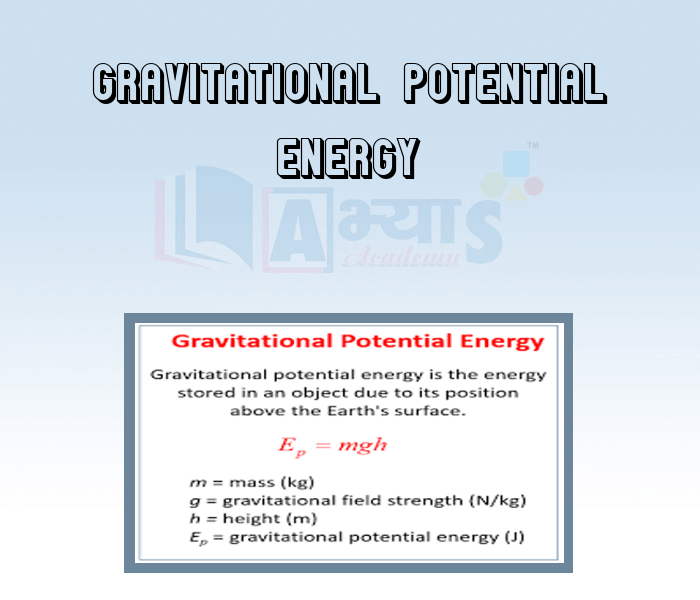Gravitational Potential Energy










Gravitational Potential Energy
Gravitational Potential Energy :
The energy possessed by an object due to its height is known as gravitational potential energy. When an object is raised through a certain height above the ground, its energy increases.This is because the work is done on it against gravity while it is moving upwards. Similarly when an object is allowed to fall from higher level to a lower level it gains speed due to gravitational pull, i.e., it gains kinetic energy. Therefore, as the distance of the object from the ground level is increasing, the body is converting its kinetic energy into potential energy. The magnitude of its gravitational potential energy is equivalent to the amount of work done by the weight of the body in causing the fall.
Expression for Potential Energy:
If a mass m is at a height h above a lower level, the P.E. possessed by the mass is given by the equation
PE = mgh
Since h is the height of an object above a specified level, an object below the specified level has negative potential energy.
We know that energy in a body is due to its position is defined as the energy stored in the body. If position of the body changes with the application of the external force the change in potential energy is equal to the amount of work done on the body by the forces.

Consider an object lying at the ground. Here the potential energy is zero and its weight is acting downwards.
As the object is placed at a height h above the groun d level we have to apply minimum force mg equal to the weight of the object.
Thus work is being done against gravity is being converted into to potential energy
Work done = Force X displacement
W = F X s
As force F = mg
displacement s = h
Therefore, W = mg X h
PE = mgh
The energy results from the force of attraction mg between the earth and the object. From Newton's third law of motion, the earth and the object attract each other. In actual we can say that the energy mgh is not the potential energy of the object alone - it is the energy of the object- earth system.
An object can have different potential energy with respect to different height.. Thus potential energy of an object is a relative term as it depends on the height between the two objects.
Illustration: Calculate height through which the object of mass 1 Kg we raised so that it gains a potential energy of 98 J.
Solution:Given
mass m = 1 Kg
PE = 98 J
h = ?
Height can be calculated using the expression for the potential energy
PE = mgh
The work done in lifting a mass of 1 kg to a height of 9.8 m is | |||
| Right Option : B | |||
| View Explanation | |||
When a body is moving up with constant velocity: | |||
| Right Option : D | |||
| View Explanation | |||
A stone of mass 2 kg is raised through 2 m height : | |||
| Right Option : D | |||
| View Explanation | |||
Students / Parents Reviews [10]
One of the best institutes to develope a child interest in studies.Provides SST and English knowledge also unlike other institutes. Teachers are co operative and friendly online tests andPPT develope practical knowledge also.

Aman Kumar Shrivastava
10thAbhyas is a complete education Institute. Here extreme care is taken by teacher with the help of regular exam. Extra classes also conducted by the institute, if the student is weak.

Om Umang
10thI have spent a wonderful time in Abhyas academy. It has made my reasoning more apt, English more stronger and Maths an interesting subject for me. It has given me a habbit of self studying

Yatharthi Sharma
10thBeing a parent, I saw my daughter improvement in her studies by seeing a good result in all day to day compititive exam TMO, NSO, IEO etc and as well as studies. I have got a fruitful result from my daughter.

Prisha Gupta
8thMy experience was very good with Abhyas academy. I am studying here from 6th class and I am satisfied by its results in my life. I improved a lot here ahead of school syllabus.

Ayan Ghosh
8thAbhyas Methodology is very good. It is based on according to student and each child manages accordingly to its properly. Methodology has improved the abilities of students to shine them in future.

Manish Kumar
10thAbout Abhyas metholodology the teachers are very nice and hardworking toward students.The Centre Head Mrs Anu Sethi is also a brilliant teacher.Abhyas has taught me how to overcome problems and has always taken my doubts and suppoeted me.

Shreya Shrivastava
8thMy experience with Abhyas is very good. I have learnt many things here like vedic maths and reasoning also. Teachers here first take our doubts and then there are assignments to verify our weak points.

Shivam Rana
7thIt was good as the experience because as we had come here we had been improved in a such envirnment created here.Extra is taught which is beneficial for future.

Eshan Arora
8thMy experience with Abhyas academy is very good. I did not think that my every subject coming here will be so strong. The main thing is that the online tests had made me learn here more things.
